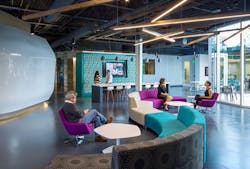It takes a generation for society to integrate a significant innovation, tech guru John Seely Brown argues. Healthcare exemplifies how technology innovations like digital connectivity and artificial intelligence are playing out in ordinary life—more evolution than revolution.
An article by Eva Hagberg Fisher in the latest Dialogue describes changes in healthcare that reflect how digital tech’s integration finds synergy with broader trends like walkable urbanism and wellness. The former favors a richer, denser mix served by transit; the latter emphasizes prevention through lifestyle changes and self-care. Both put more emphasis on community support, with healthcare providers redefining their roles and facilities accordingly.
The emergence of local healthcare clinics speaks to this. Hagberg Fisher gives two examples. The first collocates traditional patient care services with housing and jobs counseling delivered by others. It is sized and staffed to serve the urban neighborhoods around it. The second adds community-serving healthcare to a hospital with a world-famous trauma unit. Transit accessible from adjoining districts, it caters to a larger cohort. But both adhere to the wellness model.
Wellness takes a holistic view of health. Holistic medicine looks beyond prevention to ask how treatment can integrate medical research, technology and expertise. Artificial intelligence has a growing role in speeding diagnoses and treatment design, but in the context of whole-patient care that is the hallmark of healthcare’s new paradigm. Treatment is team-based, and tech is on the team, but so are the patients—more empowered than ever to help themselves get better.
Human-centered healthcare design maps closely to this. The teamwork that holistic medicine needs is supported spatially with greater transparency where it matters—whenever patients, caregivers and researchers can benefit from seeing and learning from each other, for example. A state-of-the-art rehabilitation hospital with double-height physical therapy settings for hands-on, team-delivered care is the most dramatic of Hagberg Fisher’s examples, but she has others that illustrate how digital technology impacts healthcare facility design in more ordinary ways.
Take the waiting room. Better scheduling means that fewer people need to wait. Digital check-in removes a layer of clerical work, enabling staff to focus on patients. Waiting rooms could shrink (or disappear) or be rethought to isolate sicker and contagious patients from others. Medical centers, meanwhile, are asking how best to incorporate flat screens into patient rooms to facilitate consultations that may conference in other specialists—or involve a virtual doctor.
Grass-roots wellness, the other side of holistic healthcare, is also on the rise. Here, yoga in The PNC Plaza, Pittsburgh. Photo: Connie Zhou.
Technology’s impact is woven into the everyday. Hagberg Fisher’s healthcare informants cite airports as precedents that prove a given strategy’s broad acceptability, even as they note how technology is reshaping medicine by improving diagnoses and extending the range of medicine to places like Africa that face severe shortages of trained personnel. Like much else that’s new, the changes are incremental rather than dramatic, and rooted most of all in human experience.
About the Author
Gensler
A global design firm with more than 5,000 practitioners networked across five continents, Gensler features insights and opinions of architects and designers on how design innovation makes cities more livable, work smarter, and leisure more engaging. Our contributors write about projects of every scale, from refreshing a retailer’s brand to planning a new urban district, all the while explaining how great design can optimize business performance and human potential. For more thought leadership and blog content, visit our Research & Insight page. Follow us on Facebook, LinkedIn, and Twitter.
